
Yourba Spiritual System and Philosophy

| There are various religious systems in Africa that share many commonalties. To discuss them all in their intricacies would take volumes. This page will attempt to focus on the Yoruba spiritual philosophy of West Africa. It stresses an extremely ancient rooted African tradition of working with natural forces and the ancestral realm to better one's life. Its system of divination in fact has led some scholars to remark on its similarity to Eastern philosophical beliefs such as those found among the Chinese in the I Ching. And while it may not be as ancient as Nilotic beliefs, it is the African spiritual system that can be best called a world religion. |
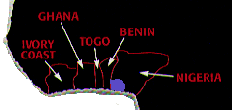
Map showing strong centers of Yoruba belief
|
The origins of Yoruba religion lie at Ille-Ife', a holy city that is regarded as the cradle of civilization for the Yoruba of Southwestern Nigeria. Currently there are 20 million or more people who speak Yoruba as their mother tongue. Yoruba-speaking communities have lived in other West African countries
for centuries. When speaking of a "Yoruba spiritual system," we are discussing traditional beliefs of those who speak the language and not the more modern religions some may practice today (Christianity, Islam, etc.) Over the years the Yoruban spiritual system has taken on the characteristics of a world religion. With the trans Atlantic Slave Trade, the Yoruba religion was transplanted in various parts of the western hemisphere. Today it is practiced in a host of different forms. One of these is Vodoun, a mixture of Yoruba, Catholicism, and Freemasonry, in Haiti. It is known throughout South America, the Caribbean, and Central America as Santeria where it is practiced not only by Africans but also the descendants of indigenous peoples (misnomered Indians or Hispanic) that inhabit the region. Worship in the Yoruba religion is based upon the belief in a Supreme Being (Oldumare), the creator of Heaven (Orun) and Earth (Aye); the belief in a multitude of spiritual deities (Orisha); and the belief in ancestral spirits (Egungun) |
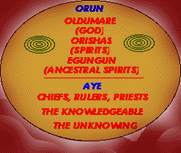
| The Yoruban spiritual system has been described as a pyramid with five layers. At the apex is Oldumare, the Supreme Being. The second layer beneath the Supreme Being is composed of lesser deities called Orisha. Below these deities are ancestral deities called Egungun. While all of the above are noted as spiritual beings, the next two layers of the pyramid consist of human beings. Firstly there are the kings, queens, chiefs, priests and priestesses while at the last layer are devotees. The Yoruba universe has a "heaven" and an "earth" which differs from the Western view. The Yoruba divide the physical world into two planes, the upper Outerworld (Orun) and
the world of the living (Aye). This universe is often pictured as sphere. Orun is the home of Oldumare, Creator and Supreme Being. It is also home to the Orisha and the ancestral spirits, Egungun. The heavenly plane (Orun) has two dimensions: simply put, a good heaven and a bad heaven. Earthly deeds and character decide which heaven one travels to when one dies. In traditional Yoruban belief there is no "hell" nor is there a "devil" in the western sense. It was not until 1850AD, with the influence of Christianity and Islam, that a "devil" was assigned to the Yoruba spiritual system. |
The Yoruba believe in the existence of spiritual beings or divinities. Called Orishas, they are seen as emissaries of Oldumare from whom they
emanated. These Orisha are ancestors whose great deeds earned them divinity. The Orisha are said to recognize themselves and are recognized through a host of different numbers and colors. These polarities which each Orisha exhibits are expressed as personalities called Roads or Paths of the Orisha. This is done through offerings to Orisha of their particular favorite foods and other gifts. One can learn much about these different Orishas by watching the forces of nature at work about you. These Orishas can be contacted during a "bembe" where one or more of their priests will be mounted in a form of highly spiritualized trance possession. This possession by an Orisha is an integral part of Yoruba religious ritual as it serves as a means of communicating with the forces of Oldumare (God).
|
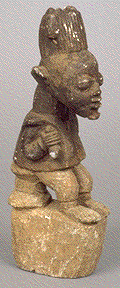 | An example of one of these Orisha is Eshu-Elegba. The youngest, cleverest and most complex of the Orishas, he is heralded as the divine messenger. Possessing 21 distinctly different Paths (personalities), he is considered the keeper of the spiritual life force, Ashe. He is also regarded as the enforcer for he
punishes the breakers of divine law. Often wild and rambunctious, Eshu must be appeased first or he may
disrupt or misguide prayers and offerings. These offerings are given to a shrine dedicated to him. Eshu
enjoys possum, smoked fish, corn, okra, gin, rum, tobacco and palm oil. His colors are black and red and
black and white, while his emblems are the comb, whistle and spoon. It was Eshu who was incorrectly
given the role of a "quasi-devil" as Yoruba philosophy was influenced by western theology. |
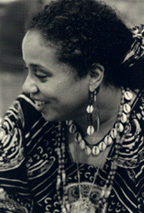 | Yemoja is another important Orisha in the Yoruban spirtual system. A Nupe princess, Yemoja is the deity of the Ogun River. In the western hemisphere she is associated with the seas, lakes and oceans and is acknowledged as the Queen of such. Yemoja's relation to water makes her a maternal deity who is regarded as the Mother of All. She is associated with the color of the sea, blue, while her symbol are fish. Her number is seven and she has seven paths Like the sea, she is deep and unfathomable. Her sacred animals are the hen, guinea hen, duck, pigeon, lamb and she-goat. Pictured here is Omifunke, a priestess of Yemoja. |
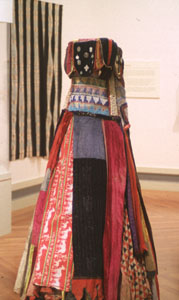 | The egungun in Yoruba are the ancestral spirits of the people. Annual or biennial egungun festivals are held to request blessings that these ancestors may be able to provide. The layered costume of multi-colored and textured fabrics seen here is worn during the egungun festival. The identity of the dancer is completely thus becoming more like the disembodied spirit of the ancestor that his dance seeks to honor. The word egungun can be translated as "powers concealed." The power and purpose of the costume only comes together in the presence of the spirit-ancestors. The job of the dancer centers around bringing the costume to flamboyant life, and to allow the egungun mask to transform his corporeal human body into something otherworldly and ethereal. |
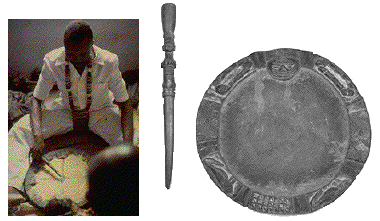
The Babaloawo,Diviner, holds a sacred place in Yoruba spirituality. It is the Babaloawo who calls upon Ifa, the oracle of divination who mediates between the Orishas, Egungun and men. The priest is able to thus suggest actions and give solutions through his divination with these deities. Pictured here is a Babaloawo with some of his tools of divination. |
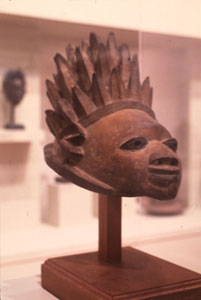
In all of Africa, masks play an important role in religious ceremonies and sacred festivals. This particular Gelede mask illustrates the power of women in a distinct African society. The annual Gelede festival of the Yoruba of Nigeria honors the creative and mighty powers of women elders, female ancestors, and goddesses. Elderly women are affectionately referred to as 'our mothers' among the Yoruba people. These mothers are respected and feared for their spiritual powers that can be used either to benefit or ruin society. They can bring fertility, prosperity, health, and rain to Yorubaland but they can also bring drought and diseases. In the same way, the mothers control fertility of the land and of the people. The Gelede festival is the remedy for the communal distress that is caused when there is a drought or a threat of not having enough children. In the Gelede festivals, the dancers appease the powers of the mothers by paying tribute to them. In this way, they are activating the spiritual powers of the mothers in order to communicate and connect with the generation that is involved in the masquerade. The festival encourages the mothers to use their extraordinary powers for the well-being of the community by ensuring human fertility and fertile lands. This particular mask, with its spiky points jutting out of the serene and calm lower face, probably represents the courage of the respected woman. On each mask, the lower part depicts a woman's face, showing qualities such as serenity, calmness, patience, and "coolness" that are the most sought after by Yoruba women. |
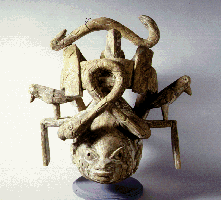 |
This Gelede carving illustrates a woman's head upon which sits birds and snakes. The birds represent the nocturnal powers of women who the Yoruba belief act as witches. This is balanced out by the snakes which symbolize positive feminine qualities of patience and coolness. In Yoruba philosophy witches are respected beings who, if properly respected, can bring blessings to the people. This particular acknowledgement of feminine power is thought perhaps to balance out the fact that in many traditional cultures mostly men are priests. |
 |
The annual Epa festival of the Nigerian Yoruba celebrates the important social roles of a town: its chiefs, farmers, warriors, hunters, priests, and women. This very practical nature of Yoruba spiritual system isb a common African trait. Pictured here is a ceremonial mask worn by the dancer in this celebration.(Photos and Information courtesy of The Yoruba Religion by Conrad E. Mauge, Yoruba Art in Wood and Metal by Indiana University, Masking Page by Middlebury University and the Yoruba Studies Association) |











